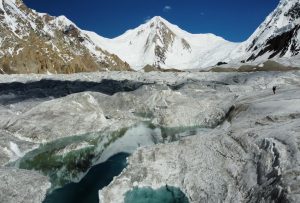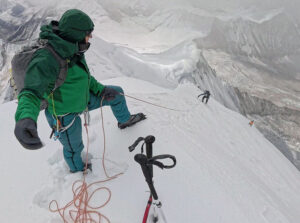Adam Bielecki’s third attempt to open an alpine-style line on Annapurna’s 3,000m NW Face didn’t go according to plan. But it put him and fellow Pole Mariusz Hatala in a position to assist yesterday in a daring rescue on Annapurna.
What happened on the NW Face? The original third member of their team, Felix Berg, decided to climb Manaslu instead, possibly to join them later. Meanwhile, Bielecki and Hatala got their first glimpse of the face from a side valley adjacent to the normal route’s Base Camp. Conditions looked far from promising.
After a dry winter, there was little ice on the wall to bind the loose rock together. They learned this the hard way. During the same weather window when other climbers summited Annapurna’s normal route, Bielecki and Hatala launched their own attempt on the face until one of the rotten pieces of rock struck Bielecki’s helmet. The pair eventually retreated.
On Wednesday, the Polish climbers were pondering their options when Chhang Dawa Sherpa of Seven Summit Treks contacted them. Suddenly, they were involved in a totally different kind of adventure.

This shot of Adam Bielecki inside the crevasse, while Anurag Maloo is being hoisted out above him, has become the most impressive image of the current Himalayan season. Photo: Adam Bielecki
Despite some communication problems — Thuraya satphones and snowstorms apparently don’t get along well — we spoke with Bielecki about the miraculous rescue of Anurag Maloo from 60 meters inside a crevasse, as a major storm settled in. He is currently in Annapurna’s normal Base Camp, while a storm rages outside the tent.
Adam Bielecki’s story:
After retreating, we returned to Annapurna Base Camp on Monday, to find it completely empty. It was bizarre since a couple of days before, we had left a crowded Base Camp. On Wednesday, we were resting inside our tent, when Dawa of Seven Summit Treks flew to BC and asked for our help in rescuing Anurag Maloo. He had dropped from an untied end of a fixed rope and fallen in a crevasse between Camp 3 and Camp 2. Since we were the only people technically able to go in and out of a crevasse, we agreed.
The next day at 6 am, we flew from Annapurna BC to slightly above Camp 2. There was seven of us, five Nepalese and us. We flew in three flights. From the landing point, it took us 20 to 30 minutes to reach the crevasse, or rather a bergschrund, under the couloir leading to Camp 3. This is precisely the most dangerous part of Annapurna’s normal route. All climbers hurry to pass this place as fast as possible. We had to deal with two main issues: One was to find and retrieve Anurag, and the other was operating in that unpleasant, dangerous zone.
As a climber, I am strongly focused on avoiding objective risks. I don’t mind climbing hard, technical routes, as long as I can control the risk. Which we definitely couldn’t here: There were two seracs by the couloir that could fall at any moment.
Video courtesy of Adam Bielecki. The half-buried figure in yellow at the end of the clip seems to be the unconscious Anurag Maloo.
The crevasse was one of those huge ones, really big. I rappelled into it, and by the time I reached Anurag’s body some 60 meters under the ice, I had nearly run out of rope. I was expecting to retrieve a dead body, so try to imagine my surprise when I saw that he was breathing, his eyes reacted to light, and his body shivered a little. The feeling of joy that wraps you is indescribable. What we were doing was not a recovery operation but a rescue mission!
Mariusz Hatala (green jacket) operates the pully system while Tashi Sherpa films from inside the crevasse. Frame from a video by Adam Bielecki
Tashi Sherpa went down into the crevasse too, and we prepared Anurag and clipped him to the complex pulley system that Mariusz had prepared. I could now stand on my own rope, navigating Anurag through the irregularities of the crevasse, while the others operated the pulley system. Once out, everything happened very fast. The helicopter picked him up, took him down to BC, and then to the Pokhara hospital. We downclimbed 200 meters to get away from the dangerous area and then waited for the helicopter to take us back to BC. It was great teamwork. The whole operation took about 6 hours.
Video courtesy of Adam Bielecki.

Anurag Maloo was transferred from Pokhara to a Kathmandu hospital yesterday afternoon. Photo: The Quint
Next, Annapurna normal route?
Bielecki and Hatala were perfectly aware of the dangers when they undertook the rescue. “In fact, as I approached the area, I really wondered if I wanted to climb Annapurna’s normal route,” said Bielecki. “But you know, somebody asked for help, and we were the only people around who could do the task, so we believed we had to go.”
Now they are sitting in the lonely Base Camp, waiting out the bad weather. Which is really very bad, Bielecki said. “We were considering climbing Annapurna up the normal route but at this moment, I don’t know if we will. The weather is horrible, and it’s snowing non-stop. Anyway, we’ll see.”

Adam Bielecki and Mariusz Hatala some weeks ago while they prepared for the Annapurna NW Face expedition in Chile. Photo: Adam Bielecki/Facebook







